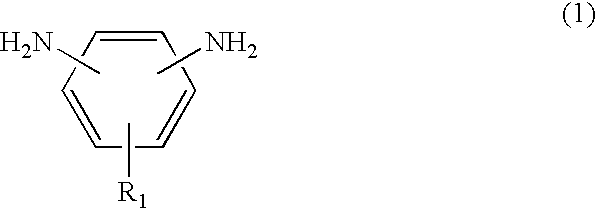Aligning agent for liquid crystal and liquid-crystal alignment film obtained with the same
a technology of aligning agent and liquid crystal, which is applied in the direction of thin material processing, instruments, chemistry apparatus and processes, etc., to achieve good uniformity and good uniformity of coating films
- Summary
- Abstract
- Description
- Claims
- Application Information
AI Technical Summary
Benefits of technology
Problems solved by technology
Method used
Image
Examples
preparation example 1
[0038]In a nitrogen atmosphere, in a 500 ml four necked flask, 1.42 g (0.03 mol) of 1,3-diamino-4-(trans-4-heptylcyclohexyl)phenoxybenzene and 7.57 g (0.07 mol) of p-phenylenediamine were dissolved in 170 g of N-methyl-2-pyrrolidone (hereinafter referred to simply as NMP). Then, 4.90 g (0.075 mol) of 1,2,3,4-cyclobuthanetetracarboxylic dianhydride and 18.77 g (0.025 mol) of bicyclo[3,3,0]octane-2,4,6,8-tetracarboxylic dianhydride were added, followed by polymerization at room temperature for 5 hours to obtain a polyamic acid solution.
[0039]100.0 g of this polyamic acid solution was put into a 300 ml four-necked flask, and as an imidation catalyst, 21.0 g of acetic anhydride and 16.3 g of pyridine were added, followed by a reaction at 90° C. for two hours to obtain a soluble polyimide solution. This solution was poured into 2,400 ml of methanol, and an obtained white precipitate was collected by filtration and dried to obtain a white polyimide powder (PI). The obtained polyimide powd...
preparation example 2
[0040]In a nitrogen atmosphere, in a 500 ml four-necked flask, 11.42 g (0.03 mol) of 1,3-diamino-4-(trans-4-heptylcyclohexyl)phenoxybenzene and 7.57 g (0.07 mol) of p-phenylenediamine were dissolved in 170 g of NMP. Then, 4.90 g (0.075 mol) of 1,2,3,4-cyclobuthanetetracarboxylic dianhydride and 18.77 g (0.025 mol) of bicyclo[3,3,0] octane-2,4,6,8-tetracarboxylic dianhydride were added, followed by polymerization at room temperature for 5 hours, to obtain a polyamic acid solution. This solution was put into 1,000 ml of methanol, and an obtained white precipitate was collected by filtration and dried to obtain a white polyamic acid powder (PAA).
example 1
[0041]Into a 100 ml eggplant type flask, 2.75 g of the polyimide powder obtained in Preparation Example 1, 5.50 g of NMP and 19.25 g of γ-butyrolactone (hereinafter referred to simply as BL) were added and dissolved with stirring at 70° C. for 24 hours. The obtained dissolved solution was then diluted with 3.75 g of NMP, 5.75 g of BL, 6.50 g of dipropylene glycol monomethyl ether (hereinafter referred to simply as DPM) and 6.50 g of diethylene glycol diethyl ether (hereinafter referred to simply as DEDE) to obtain a liquid crystal aligning agent.
[0042]This liquid crystal aligning agent was printed on cleaned glass substrates provided with ITO electrodes by flexographic printing by means of an alignment film-printing machine (“ANGSTROMER” manufactured by Nissha Printing Co., Ltd.). The substrates after the printing were left on hotplates of 50° C., 65° C. and 80° C., respectively, for five minutes to carry out preliminary drying of the coating films.
[0043]The film surfaces after the ...
PUM
| Property | Measurement | Unit |
|---|---|---|
| temperature | aaaaa | aaaaa |
| temperature | aaaaa | aaaaa |
| temperature | aaaaa | aaaaa |
Abstract
Description
Claims
Application Information
 Login to View More
Login to View More - R&D
- Intellectual Property
- Life Sciences
- Materials
- Tech Scout
- Unparalleled Data Quality
- Higher Quality Content
- 60% Fewer Hallucinations
Browse by: Latest US Patents, China's latest patents, Technical Efficacy Thesaurus, Application Domain, Technology Topic, Popular Technical Reports.
© 2025 PatSnap. All rights reserved.Legal|Privacy policy|Modern Slavery Act Transparency Statement|Sitemap|About US| Contact US: help@patsnap.com

